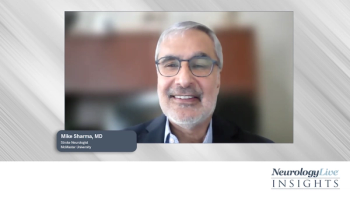
Using Hematopoietic Stem Cell Transplantation in Multiple Sclerosis
The chief of the Division of Immunotherapy at the Northwestern University Feinberg School of Medicine discussed the results of the randomized clinical trial and the implications of this treatment in clinical practice.
Richard K. Burt, MD
Recently, Richard K. Burt, MD, chief, division of immunotherapy, Northwestern University Feinberg School of Medicine, and a group of investigators explored the difference between treating patients with relapsing multiple sclerosis (MS) and nonmyeloablative hematopoietic stem cell transplantation (HSCT), with results leaning in favor of the HSCT group.
Ultimately, the randomized clinical trial showed that 3 of the 55 patients treated with HSCT had disease progression at 1 year based on the Expanded Disability Status Scale (EDSS) scores. The HSCT group experienced a 1.02-point reduction in EDSS score, compared to a 0.67-point increase in the DMT group (P <.001), in which 34 of 55 patients showed disease progression.
To discuss these results further and to find out what the implications of this treatment could be for clinical practice, Burt spoke with NeurologyLive® in an interview, including detailing the patient population for which this would be best suited.
NeurologyLive®: What prompted this research with HSCT in MS?
Richard Burt, MD: I was a fellow at Johns Hopkins, and people were coming back to the outpatient stem cell transplant department after a transplant for leukemia or lymphoma. They had lost their memory response to measles, mumps, rubella, tetanus, childhood vaccines—so they were reimmunizing them, and it hit me. I actually had an attending there and I said, “you know, you're reimmunizing these people. That means they lost their memory, their lymphocyte response to these antigens. That means we could use this in autoimmune disease.” Then he stopped, and looked up at me and said, “We could do this in MS.” So, I started working in animal models of MS in the basement lab there at Hopkins, and preclinical proof of concept, into phase 1 and then 2, and then, finally, the randomized trial.
What’s the main takeaway from the data for the clinician community?
I think there's a lot of confusion. We're not trying to repair or build new neurons or oligodendrocytes, we're just trying to reset the immune system. All treatments MS have been immune-based, and that's all this is, except instead of a chronic forever treatment that you change according to toxicity or response, it's just a 1-time treatment and then you stop all drugs.
The concept is you knock the immune system down with immune-specific drugs—they'll recover even if they don't get the stem cells. But the stem cells are really an autologous blood transfusion that makes the recovery faster, so they are out of the hospital by 8, 9, or 10 days after the transfusion of the stem cells. That's all it is.
The drugs we use are just standard drugs used all the time. Even at the doses we used, they're used all the time in hematology, oncology, or autoimmune diseases, and basically, we give them over 5 days and then give them to stem cells, and about 9 days later, discharge them.
The non-randomized data were really positive—showing results no drug ever showed. The randomized construct turned out even better, so that was surprising. But I think a reason it turned out even better was when we first started, this we had to do it in secondary progressive MS because there was an Oversight Committee that said that's where you have to start, but our animal models suggested it wouldn't work there because that's neurodegenerative, but not inflammatory. But back when we started, that wasn't really clear—it's much clearer now in the field—and it didn't help. My first paper on that in Blood, I put “failure” in the title because it won't work in secondary progressive. The animal models predicted that. Even though a regulatory panel had us start there, it didn't hurt but didn't help. This won't work in progressive disease and you shouldn't try it there. Where any immune-based therapy works an MS is relapsing, so then we focused there.
Nobody had done randomized trials, so when we did, we selected people having frequent relapses despite at least upfront therapy. Many had had more than just interferon or glatiramer acetate, they used the other drugs as well but were still having 2 or more relapses in the last year that were confirmed relapses. That group did very well because this is designed for inflammatory MS—the more inflammatory, the better the response for the treatment.
The results turned out even better. When we started, we had little to go on to predict because it was a reasonable guess based on what was available in the literature, which was very little. That guess was 110 patients, and with that, we had very high p-values of less than .001, on almost all on our primary outcomes and almost all our secondary outcomes because it ended up being even more effective than we thought. We predicted the difference would be large and so we would be able to do a smaller number of patients, and, in fact, that held that very true. Even better than we thought. I think it's because of the selection—that's the key.
Were any data or subgroup analyses surprising or unexpected in any way?
We were asked to look at the subgroup on the control arm that got natalizumab because we were allowing the treating neurologists, who was blinded to treat with what he or she thought was the best judgment as long as it was an FDA-approved drug. It was surprisingly more effective in natalizumab and subgroup analysis, but that could be potentially misleading because people the treating neurologist may have selected natalizumab because they thought the patients were worst actors upfront.
All the drug companies compared their drug against glatiramer acetate or interferon, even with the newer ones, whereas we compared whatever was FDA-approved out there, so it's actually a stricter comparison. We didn't want to do subgroup analysis, but with the natalizumab group, it was still markedly positive. But subgroup analysis on a small study that you didn't design to do that way, puts in the biased that they took the worst actors and put them on natalizumab innately in their practice, so we have to be careful on that conclusion. But our control was stricter than what's out there with any of the drugs.
Does this impact clinical practice in any way?
You have to take inflammatory disease—the more inflammatory the better. You don't want to do this upfront because a lot of patients present with MS and do fairly well without much activity or acute relapses or burden of disease in the brain on just interferon or glatiramer acetate—you don't want to touch those people. But if you get the bad actors with a lot of frequent attacks, that's a group this will work on. But of course, you don't want to do secondary progressive or primary progressive, so that's primarily axonal degenerative at that point and immune-based therapies just aren't effective with them.
I think it's applicable to about 15% of patients with MS, but I wouldn't use it for the majority. For the bad actors, it's really effective therapy.
What still needs to be done to confirm this as a treatment method in MS?
We did this a long time ago in systemic sclerosis, another autoimmune disease, and reported our randomized trial in The Lancet. We stopped it early because people died with that disease and the transplant arm was doing so much better—all the organs getting better because you it affects the heart, lungs, kidneys, everything—and on the drugs they were getting worse. That was repeated by another group in Europe and they reported results in JAMA and the transplant was better, and then finally the Duke group reported their results in the New England Journal of Medicine in 2018, and transplant with superior even in just mortality. Three randomized trials, they're all showing the transplant is superior, and so I suspect there'll be others to follow.
Is there anything you’d like to add?
The final take-home point is this could be highly cost-effective. If you look at the cost of these drugs that go on kind of indefinitely compared to one-time treatment here, it could be highly cost-effective. That's also a positive when you can make it cheaper for insurance or for the government or public health. There are only so many all resources that are always limited whether it's a government or a group of people insuring themselves for private insurance, so there's a promising future for this. One of the things we want to do is look at cost-effectiveness and our university has finally given us the approval to hire someone to do that. All these things get much deeper when you get into details and, of course, both the devil and the angel lie in the details. That's what we want to take a look at that in the future.
REFERENCE
Muraro PA, Pasquini M, Atkins HL, et al. Long-term Outcomes After Autologous Hematopoietic Stem Cell Transplantation for Multiple Sclerosis. JAMA Neurology. 2017;74(4):459-469. doi:10.1001/jamaneurol.2016.5867
Newsletter
Keep your finger on the pulse of neurology—subscribe to NeurologyLive for expert interviews, new data, and breakthrough treatment updates.


































